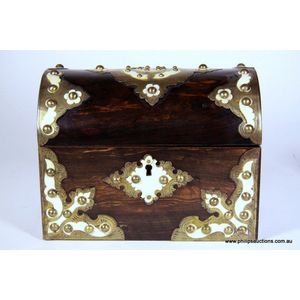Victorian Gothic Burr Walnut Casket
You must be a subscriber, and be logged in to view price and dealer details.
Subscribe Now to view actual auction price for this item
When you subscribe, you have the option of setting the currency in which to display prices to $Au, $US, $NZ or Stg.
- Ivory - Ivory is a hard white material that comes from the tusks of elephants, mammoth, walrus and boar, or from the teeth of hippopotamus and whales. The ivory from the African elephant is the most prized source of ivory. Although the mammoth is extinct, tusks are still being unearthed in Russia and offered for sale.
Ivory has been used since the earliest times as a material for sculpture of small items, both in Europe and the east, principally China and Japan.
In Asia ivory has been carved for netsuke, seals, okimono, card cases, fan supports, animals and other figures and even as carved tusks.
In the last 200 years in Europe ivory has been used to carve figures, for elaborate tankards, snuff boxes, cane handles, embroidery and sewing accessories, in jewellery and as inlay on furniture. Its more practical uses include being used for billiard balls, buttons, and a veneers on the top of piano keys.
The use and trade of elephant ivory have become controversial because they have contributed to Due to the decline in elephant populations because of the trade in ivory, the Asian elephant was placed on Appendix One of the Convention on International Trade in Endangered Species (CITES), in 1975, and in January 1990, the African elephant was similarly listed. Under Appendix One, international trade in Asian or African elephant ivory between member countries is forbidden. Unlike trade in elephant tusks, trade in mammoth tusks is legal.
Since the invention of plastics, there have been many attempts to create an artificial ivory - Burr - Burr (or in the USA, burl) is the timber from the knotted roots or deformed branch of the tree, which when cut, displays the small circular knots in various gradations of colour. It is always cut into a decorative veneer, most commonly seen as burr walnut on 19th century furniture.
- Damask - Damask is a type of fabric that is characterized by its glossy finish, smooth texture, and intricate designs. The fabric is typically made from a combination of silk and other natural fibers, such as cotton or linen, and is often used to make clothing, upholstery, and other decorative items.
The origins of damask fabric can be traced back to ancient Rome and the Byzantine Empire, where it was used to make clothing and other textiles.
The fabric is made by weaving the fabric in such a way that the design is created by the different reflectivity of the warp and weft threads, rather than by the use of dyed threads. The designs are often floral or geometric patterns and can be very intricate. The effect is a reversible fabric, with a glossy pattern on one side and a matte pattern on the other. - Victorian Period - The Victorian period of furniture and decorative arts design covers the reign of Queen Victoria from 1837 to 1901. There was not one dominant style of furniture in the Victorian period. Designers used and modified many historical styles such as Gothic, Tudor, Elizabethan, English Rococo, Neoclassical and others, although use of some styles, such as English Rococo and Gothic tended to dominate the furniture manufacture of the period.
The Victorian period was preceded by the Regency and William IV periods, and followed by the Edwardian period, named for Edward VII (1841 ? 1910) who was King of the United Kingdom and the British Dominions and Emperor of India for the brief period from 1901 until his death in 1910.
This item has been included into following indexes:
Visually similar items

A Victorian Gothic revival coromandel casket, circa 1880s, the dome arched box with shaped brass and ivory strapwork with studding in the Gothic manner, with a moire silk taffeta lined interior in purple and cream; with key. Height 14.5 cm. Width 19.5 cm.

Victorian burr walnut dome top tea caddy, with cut brass mounts, interior empty, 24 cm wide, 16 cm high

Antique brass decorated tea caddy, 21 cm x 13 cm, 13.5 cm high approx.

A quality Victorian Cuban mahogany treasure chest with ornate gilt brass strapping and fittings, the strap work with multiple brass screw fittings, studded detail to front, double push button front release, swing side handles, in original condition with va
